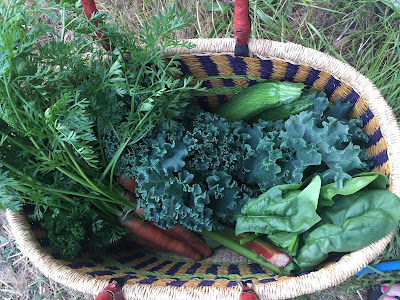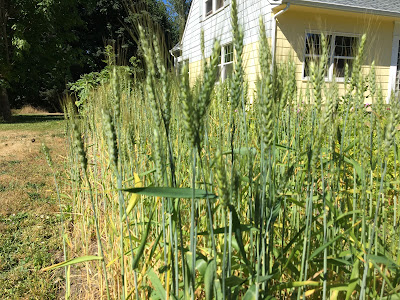When we first started preserving food, we didn't know what we were doing. Canning initially seemed to be the thing to do, however, canning is very time consuming. We've come to realize how much easier it is to freeze food and how more nutrients are saved by freezing rather than canning. We still enjoy having a portion of our preserved food as canned for the sake of convenience and because we have limited freezer space. But at least half of what we save nowadays is either frozen, fermented or dehydrated.
I wanted to share with you the ways in which we have been preserving the harvest this year, as it may inspire you to incorporate a few of these ideas into your own food storage. Below is a list of what we have preserved, along with the method, at this point in the summer.
Blanched and frozen:
- Peas
- Sugar snap peas
- Spinach
- Kale
- Broccoli
- Cauliflower
- Carrots (sliced for using in soups and stews)
- Potatoes (cut as fries and cubed for stews)

We have an upright freezer that provides enough space for our fruits and vegetables along with a small amount of meat and baked goods. Eventually, we may get a second freezer so that we can store more seafood.
Frozen (without blanching):
- Blueberries
- Bing cherries (pitted)
Dehydrated and stored in glass jars:
- Green onion tops (some of this is then powdered)
- Sage
- Basil
- Parsley
- Cilantro
- Cherries (pitted)
- Horse mushrooms (some of this is then powdered)
Minced with olive oil, frozen in ice cube trays, and then the cubes are stored in a ziplock bag:
- Basil
- Cilantro
Dried on a rack in the shop and then stored in the house in an open paper bag in a dark corner:
- Garlic
We would also like to try fermenting some garlic in honey, for adding to our apothecary. We've been reading that honey fermented garlic is good for cold and flu season.
Refrigerator Pickled:
- Eggs
Fermented:
What's coming up next?
August will be a busy month of canning green beans and tomatoes. We also plan to freeze some of both. The corn is reaching its full height. Zucchini will be coming on for a while; we plan to make zucchini pickles. Three loaves of zucchini bread are in the freezer. Plums are nearly ready for harvest, maybe we'll make some plum jam? We also enjoy eating these fresh and dehydrating them. The apples on our tree are getting bigger and should be ready in mid-fall. We're looking forward to freezing a bunch of apple pies for enjoying during the holidays, as well as canning apple sauce and pressing apples for cider. Blackberries will be ready in August, too, and that means blackberry jam, plus pies to be frozen along with bags of blackberries frozen to snack on and to use in cobbler.
This year the garden looks like a jungle. All the vegetables are growing together, covering up the pathways in between; you can especially see this problem in the photo below, where there are rows of bush beans, tomatoes and corn all growing together. The beans are climbing up the corn and the tomatoes. It's hard to find spots to put our feet as we try to harvest.
This year we planted a patch of wheat and quinoa in our front yard.
Last year, we grew quinoa for the first time and then saved some seeds. This year the harvest will be bigger now that we've learned how to grow and harvest quinoa. This is the first time we've grown wheat. I think we might have enough wheat to make one loaf of bread. The goal in growing wheat this year isn't to have enough to sustain us for the whole year, but rather to gain experience in how to grow and harvest it and to determine if it's worth the effort for us. After the flour shortage in the grocery stores, we wanted to give growing our own wheat a try.
Quinoa plants start out green but then like autumn leaves they first turn yellow, and then orange and red. I'm looking forward to seeing the colors change on these quinoa as we get closer to fall. They are a beautiful addition to our front yard.
We're still planting seeds. The fall garden will feature Brussels sprouts, black beans, pinto beans, winter squash, another round of potatoes and more cruciferous vegetables, celery, beets, more carrots and cucumbers.
A few days ago we planted organic dried pinto beans and black beans that we had bought as food (you know, the kind that comes in a baggy at the grocery store). Who knew these would grow? I always figured that since dried beans had been processed for using as food, they would no longer be viable for growing. However, after coming across a video on YouTube about it last year, we learned otherwise and I've been wanting to give it a try. As you can see above, the pinto beans have already germinated! We have a long growing season here with a first anticipated frost date in mid-November, and so I'm thinking we should still be able to grow and harvest these in time.
We hope this article helps you think of ideas for how you would like to grow, harvest and preserve foods for yourself and your family. There are many different ways to preserve your harvest, whether it's by canning, freezing, fermenting, dehydrating or curing and storing. The foods you grow at home not only taste better, they are also more nutrient-dense, and the effort of gardening provides exercise - all of which promotes a healthier lifestyle. Thank you for joining us!













Comments
Post a Comment
Thank you so much for submitting a comment! All comments are reviewed by our moderator before being posted to the blog, in an effort to help control spam.